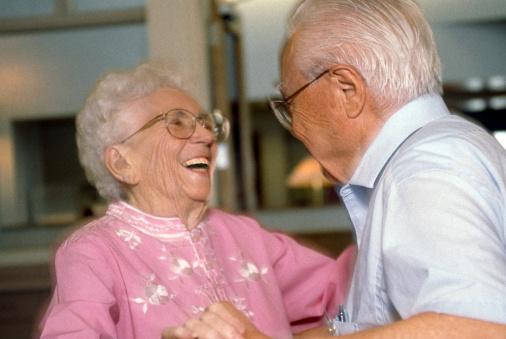
The Ultimate Guide for New Caregivers
As a new caregiver, you’re on the frontline of your loved one’s physical, mental, and emotional health. Your caregiving role may have started slowly with picking up groceries or accompanying them to the doctor, or maybe your new caregiver journey started suddenly due to your loved one’s unexpected illness.
Regardless of the circumstances, caregiving can be overwhelming at first and new caregivers may need an extra hand as they get started. To help you understand your role, overcome common challenges and get support, we’ve put together this ultimate guide for new caregivers.
10 steps to begin your new caregiver journey
1. Start the conversation with your loved one.
Caregiving is all about supporting your loved one. Any and all plans that you make as a new caregiver should be discussed first with the receiver of care.
Ideally, you would start this conversation about care before it’s necessary. Though you may dread bringing up a topic that’s uncomfortable or upsetting, it’s important to find out your loved one’s needs, priorities, and resources for future care.
Try to ease into this discussion with an open heart. You may be surprised to find out that your loved one is concerned about future care too. If they are resistant, this is also an opportunity to determine why and discuss how any fears can be overcome.
Respecting your loved one’s wishes is the key to successful caregiving. Be sure to have the talk early, so you can define priorities and review the finances to make informed decisions together.
2. Get a proper diagnosis for your loved one to identify their needs.
Perhaps you’ve noticed some signs of dementia or symptoms of a chronic condition in your loved one. Perhaps your loved one has already started receiving treatment or therapy. Whatever the case, it may be worth taking a step back and making sure your loved one has received the right diagnosis.
Getting properly diagnosed can give you important information about your loved one’s health needs now and in the future. Whenever possible, discuss your health concerns with your loved one first, and don’t schedule appointments without their permission. Your loved one may have a preferred doctor or clinic, so try to handle any medical needs within the network they are comfortable with.
As a new caregiver, attend the appointment(s) with your loved one and listen to what the experts have to say. Fully understanding the diagnosis can be the first step to creating a care plan that works.
3. Find a good fit for your loved one’s living situation.
Your loved one’s living situation is a big factor in providing care. While 90% of older adults would prefer to age in place, sometimes their care needs don’t permit it. Once you have a proper diagnosis, you can work with your loved one to identify housing options.
Choosing a care facility doesn’t necessarily mean a nursing home. There’s a continuum of care options available, including:
- An in-home aide
- Assisted living
- Adult foster care
- Memory care
- Adult daycare
- Continuing care retirement community (CCRC)
Depending on your location, your loved one may also be eligible for other community-based programs. Be sure to find out what’s available near you in order to get a full understanding of your options.
As new caregivers discover, the most important part of senior living is finding a good fit. Knowing your loved one’s priorities will help you understand how to personalize care accordingly. For example, if your parent is keen on living at home, but still has some care needs while you’re at work, adult daycare may be a good choice.
This also goes for the specific program or facility. Not all providers have the same vision for care, so you should visit potential options with your loved one to see where they feel the most comfortable. New caregivers should be sure not to rush into this process, or you may end up choosing the wrong facility.
4. Ensure safety throughout the home.
No matter where your loved one lives, it’s vital that you update the home to be safe for older adults. Here are some accessible changes you can make as a new caregiver to ensure your loved one’s safety:
- Get rid of trip hazards (rugs, cords, clutter, etc.)
- Add handrails and non-slip flooring strips
- Proof bathroom with grab bars, rubber mats, night lights, etc
- Add seating and open spaces throughout the home.
- Update lighting and get visible switches
- Replace doorknobs with levers and remove locks
- Get your loved one a medical alert device and a senior-friendly cell phone
Of course, it’s possible you may need to make more significant changes to the home. For example, a stair lift or a walk-in shower may be warranted. Don’t forget about the outside of the home, either. You may think about paving the walkway or adding a ramp.
5. Handle the legal and financial matters sooner rather than later.
As you create a caregiving plan, you’ll also want to take care of key legal and financial matters. To start, it’s critical that you discuss items such as Power of Attorney and Advance Directives with your loved one. These documents can make a difference in making sure your loved one’s wishes are respected during all stages of care.
In addition to this documentation, you’ll need to make a financial plan for how to pay for any care providers. Find out what type of health insurance and long-term care insurance that your loved one has. They may also be eligible for Medicare or Medicaid, or other community-based programs (depending on your location). If he/she has assets (such as a house), it’s also a possibility to sell it to pay for care. Exhaust your options in order to make the best possible financial plan.
Finally, it’s important to talk about end-of-life plans. Though this conversation may feel awkward, your loved one may have strong opinions about how they would like to be remembered, as well as financial plans for burial/cremation. Talking about these details ahead of time can give you both peace of mind when the moment comes.
6. Bring together your caregiving team.
Next, you should build your caregiving team. Consider family members, friends, neighbors, faith community members, and more who can help pitch in. Building this larger network will aid in avoiding caregiver burnout, and give your loved one a more diverse support system. Some potential teammates may be able to offer a meal every Sunday, create a calendar for yard chores, or offer respite care once a month. Play to the strengths of your loved one’s friends and family – they each have something unique to offer!
It can be hard to ask for help, but often these people are more than happy to pitch in. Don’t hesitate to reach out and create a group that works together to fill in care gaps and make caregiving a community effort.
7. Make a plan for your new caregiver routine.
Your new caregiver plan should include details for covering your loved one’s routine, so you’re not reinventing the wheel every week. Make a list of all your loved one’s needs and create a plan for filling them. Automating this routine can make it easier moving forward.
For example, your loved one may need assistance with:
- Bathing and dressing
- Eating
- Taking medications
- Getting groceries and cooking
- Housekeeping, including laundry
- Transportation to appointments, errands and outings
- Bill paying and other logistics
You can leverage your support team to get regular help with some of these items. For example, your faith community may offer a pick-up/drop-off to attend faith services. Or you may have a neighbor willing to help do laundry every week. You might also use technology to help, such as setting up a weekly order at your local grocery store.
Building a care routine will ensure that you have all your loved one’s needs planned for. It also helps identify areas where you still need help and may have to hire help. Understanding these care gaps is vital to strengthening your care plan over time.
8. Get trained as a new caregiver.
Depending on your loved one’s diagnosis, you may also consider getting specialized training. Even simple actions, such as transferring your loved one from a bed to a chair, can be dangerous without training.
Your loved one’s doctor may have recommendations for caregiver training. Typically, you can find courses at your local hospital or clinic. In addition, there are many online caregiving courses available today, which may be a good option for learning at your own pace.
Getting the specific skills you’ll need to care for your loved one is a good idea for safety and comfort. It will also support you when you don’t necessarily know the best way to perform certain medical basics, such as giving an injection.
9. Connect with other caregivers and community resources.
In addition to your care team, you could benefit from connecting with caregiver groups and community resources. Caregiver support groups are great for sharing tips and lending support to each other. You may even find opportunities to receive respite care.
Community services and programs are also worthwhile. You may find important support programs that will help you build a stronger care plan for your loved one. For example, you may find local resources for transportation, personal care or meal programs.
You should check directly with your local caregiver or community organization to find out what’s available. For a general idea of possible resources, you can also take a look at our list of caregiving resources, some of which may be available near you.
10. Take care of yourself.
Caregivers may feel like they’re too busy to take time for themselves. However, caregiver burnout is real and it’s important to find opportunities to recharge.
While self-care activities such as doing yoga or taking a bubble bath certainly can be relaxing, the most important aspect of self-care is simply getting time off. Work with your care team and community resources to find respite care and make it a regular thing. One you have this time blocked off, you can use it to do whatever helps you recover your energy.
Scheduling respite care is essential for being a good caregiver. If you’re feeling stressed or overwhelmed, you most likely won’t be as emotionally available to your loved one. While caregiving is rewarding, it’s also tough, so make respite care a weekly or monthly activity.
Final tips for new caregivers
With these 10 steps above, you’ll get a handle on your new caregiving role. In addition, we’ve collected some advice on how to provide care to your loved one. While some of these tips are easier said than done, hopefully you can keep them in mind as a new caregiver:
Encourage patient-first decisions.
As much as possible, encourage your loved one to take the lead on key decisions, as well as everyday activities. The more you listen, the more likely you’ll make the right choices for your loved one’s physical and emotional well-being.
Of course, sometimes it’s not possible for all decisions to be patient-first. In the case of cognitive impairment, you may have to take the reins. That’s why it’s so important to talk about future care before it’s needed, so you have a good grasp on your loved one’s priorities.
Set realistic expectations.
You can build a strong relationship with your care recipient by setting realistic expectations. As a new caregiver, you’re sure to have good and bad days. You can better overcome challenges by having a clear idea of your loved one’s capabilities and interests.
Don’t expect your loved one to perform tasks that they aren’t up to. For example, some caregivers would like their loved ones to use smart technology to enjoy video calls or listen to music. However, if you want to encourage this, be sure to teach them first. There’s no use getting frustrated about something that’s outside of your loved one’s abilities.
Prioritize comfort.
Successful caregiving is often the art of compromise. As you care for your loved one, try to prioritize comfort over other needs. Make time for those small moments of joy when you get ice cream together, even though it’s not strictly within the doctor’s nutritional plan.
After all, your loved one’s well-being depends on feeling safe and comfortable. Avoid imposing a strict regime of activities, for example. Allow your loved one to guide your care planning, so you both are at ease.
Don’t forget social activities.
Often new caregivers have all the medical and daily tasks down. But it’s easy to forget about other areas of well-being, such as social activities.
As you build a robust care plan, include areas that aren’t just related to physical and medical needs. Your loved one will thrive with a well-balanced schedule of social events and hobbies. If this sounds overwhelming, you might consider looking into programming that covers social activities, such as home companions or adult day care.
Make use of technology.
Nowadays, tons of technology can support older adults. Senior-friendly digital products include smart speakers like Alexa, smart pill dispensers, smart toilet seats, and more.
It may be worth investing in some of these products to support your loved one. For example, Alexa for seniors can be an interesting way to provide companionship and entertainment, as well as key tasks such as medication reminders.
Of course, whenever you make use of new technologies, be sure to teach your loved one how to use it so that it doesn’t become a source of frustration.
Give yourself permission to feel.
New caregivers may feel a range of emotions, such as grief and frustration, all of which are completely valid. If you try to ignore these feelings, they’ll eventually impact your ability to care. Work to accept and release your feelings, so you can stay emotionally healthy as a caregiver.
However, caregiver burnout and depression are far too common. Nearly 1 in 5 caregivers say caregiving has taken a toll on their health. If you find that you’re struggling emotionally with caregiving, especially depression, it may be worth seeing a professional for help.
Trust your new caregiver instincts.
Though we’ve gone through some expert tips for new caregivers, at the end of the day, you know best. It’s up to you to find out what works for your loved one. Trust your instincts for what they need and how to make their daily life the best possible experience.
There’s no one-size-fits-all caregiving, so listen to yourself when you think something’s not right or could be done differently.
Personalize your new caregiver plan today
Caregiving may sometimes be an emotional roller coaster. Some days, it’s the most fulfilling job in the world; other days, it can be simply overwhelming. You can build a caregiver routine that runs as smoothly as possible by applying this 10-step guide and defining the specifics of your new caregiver role.
If you’re looking for even more resources about caregiving, check out our other guides on MyCaringPlan. You might also get help from our services center, where we offer support to caregivers. We believe that everyone’s caregiving journey is different, which is why we work together to personalize your plan. Get in touch to learn how we can help.
References for new caregivers:
1. Caregiver.org, Caregiving 101, https://www.caregiver.org
2. Help Guide, Family Caregiving, https://www.helpguide.org
3. AARP, Family Caregiving Guide, https://www.aarp.org
4. Health in Aging, Caregiver Guide, https://www.healthinaging.org
Related Articles

Nursing Home Ratings: Our Rating System
My Caring Plan gathers information from sources across the web to give you nursing home ratings across the nation. My Caring Plan’s goal is to have one place you can go to find all the information you need to find the best care for your loved one. Start your search here. Our nursing home data sources […]

Home Care Ratings: Our Rating System
Our Home Care Rating System My Caring Plan gathers information from sources across the web to give you home care ratings across the nation. Our goal is to have one place you can go to find all the information you need to find the best home or care for your loved one. Start your search. Our […]

25 Ways to Say “I Hope You Feel Better”
When someone we care about is feeling under the weather, the last thing we want to do is make them feel worse. That’s why it’s important to know a variety of ways to say “I hope you feel better.” In this blog post, we will explore 100 different ways that you can show your loved […]
